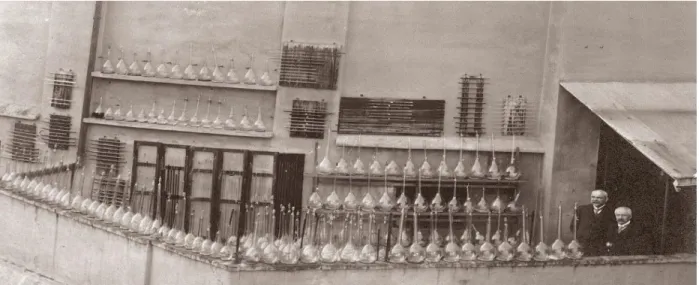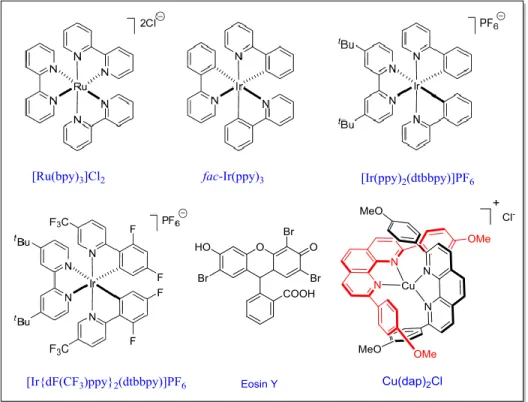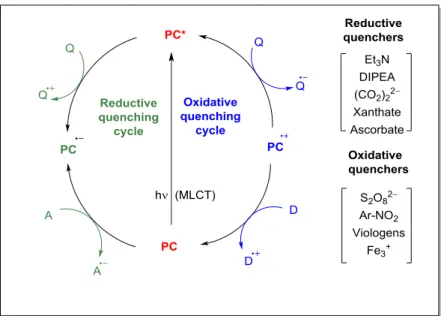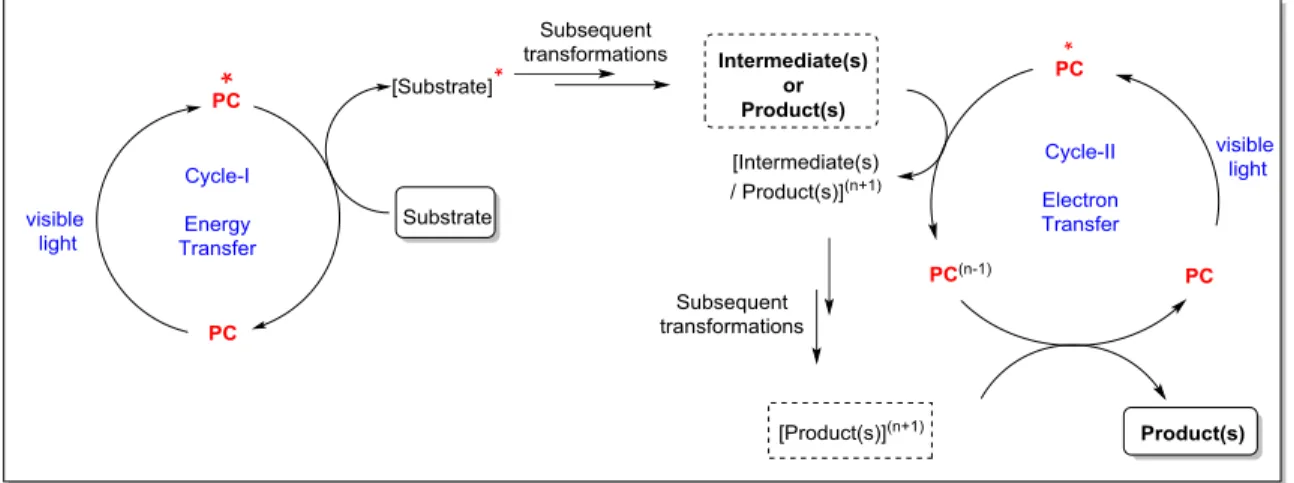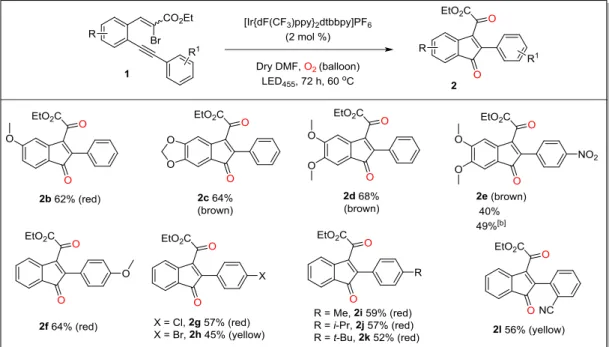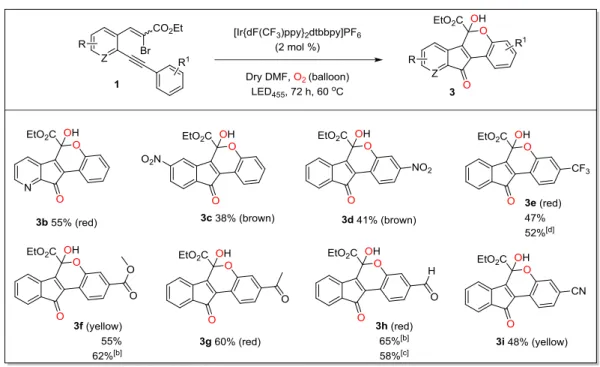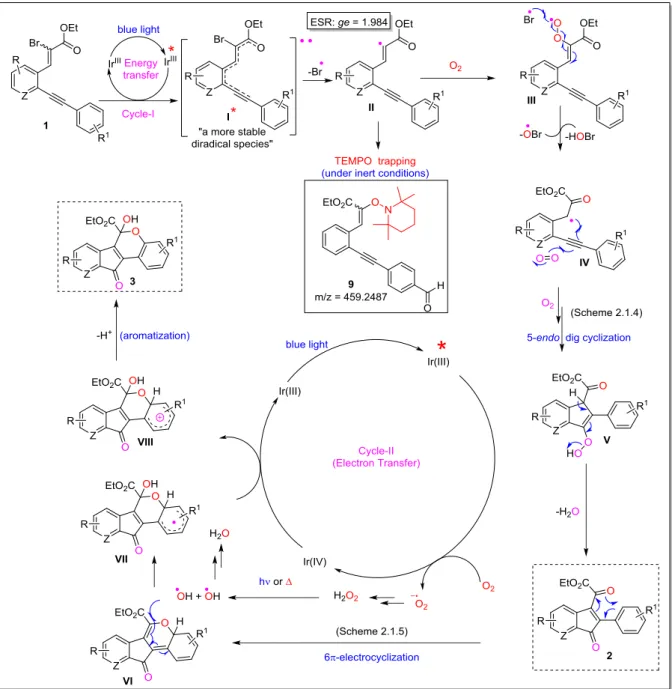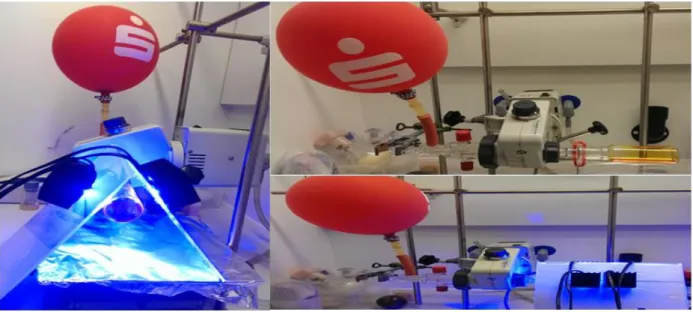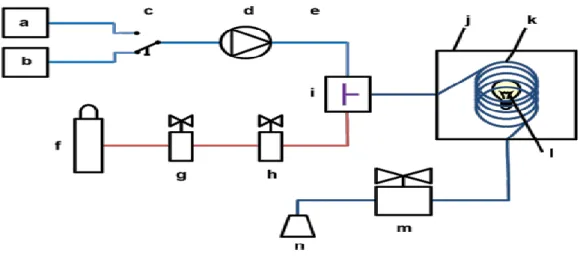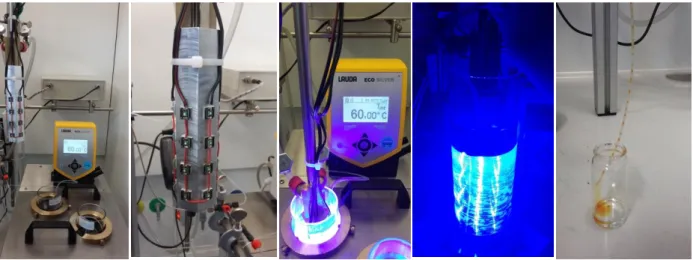Surprises and Discoveries in Visible-Light Photocatalysis
Dissertation
Zur Erlangung des Doktorgrades der Naturwissenschaften (Dr. rer. nat.)
an der Fakultät für Chemie und Pharmazie der Universität Regensburg
vorgelegt von
Santosh K. Pagire
aus
Maharashtra, Indien 2017
The experimental part of this work was carried out between October 2013 and September 2017 at the Institute of Organic Chemistry, University of Regensburg, Germany under the supervision of Prof. Dr. Oliver Reiser.
The thesis was submitted on 06.11.2017 Date of the colloquium: 08.12.2017
Board of Examiners: PD Dr. Sabine Amslinger (chair)
Prof. Dr. Oliver Reiser (1st referee) Prof. Dr. Burkhard König (2nd referee) Prof. Dr. Arno Pfitzner (examiner)
Dedicated to Sonali
“The journey is what brings us happiness, not the destination.”
-Dan Millman
(Image source: Google)
Acknowledgements
i
Acknowledgements
The work in this thesis was accomplished through the support, help, and encouragement from numerous people. First and foremost, I wish to express my deep sense gratitude and respect to my research supervisor Prof. Dr. Oliver Reiser, for giving me this unique opportunity to conduct my doctoral studies under his expert supervision and introducing me to the fascinating field of visible-light photocatalysis. I would like to thank him for providing an excellent chemical education, for his never-ending trust in me and in my projects, his continuous support, constructive criticism, open-minded praise, and his special assistance to join the overseas conferences. I particularly appreciated him for providing the unlimited freedom throughout my PhD program at the University of Regensburg. I could have never worked to the best of my capabilities under any kind of mental or physical pressure.
It is my pleasant duty to express my grateful and sincere thanks to Prof. Dr. Burkhard König for being my co-examiner. I am very happy to have him as one of the visible-light photocatalysis experts in my committee. I also thank him for writing recommendation letters in support of my DAAD applications. In addition, I particularly appreciate his offer to collaborate on a review article for Angewandte Chemie. I also thank Prof. Dr. Arno Pfitzner for being the doctoral committee members and referring my thesis. He has accepted my request without any hesitation and delay, thank you! I also like to thank PD. Dr. Sabine Amslinger for being Chairman in my PhD defense. I appreciate her quick response; although she will be on maternity leave immediately after the defense. Many congratulations for becoming a Mother, take care!!!
Generous financial supports from DAAD, GDCh, iPUR, and DFG-GRK-1626 during my doctoral studies are gratefully acknowledged. In particular, I appreciate the DAAD for providing full-time PhD scholarship, insurance, family support, and the special assistance for learning/understanding the German language and culture. Beyond that, DAAD has also supported me to attend important scientific and cultural events in Germany.
During my PhD journey, I had the chance to collaborate with excellent and hardworking students: Dr. Suva Paria, Asik Hossain, Lukas Traub, Sabine Kerres, Dr. Vidyasagar Adiyala, Julietta Yedoyan, Dr. Leyre Marzo, the part of my thesis would have never been completed
ii
without them, and I am happy to have many of them as co-authors on my publications. Dr.
Sabrina Fürst, Dr. Myungmo Lee, Dr. Sharif Najafishirtari, Dr. Vidyasagar Adiyala, and Maryam Homafar were fantastic labmates, we spent a great time together in- and outside the lab.
My special thanks go to Dr. Peter Kreitmeier for his valuable assistance, constant help, support in all the technical aspects and computer problems. I was happy to share one of my important publications together with him. I thank Klaus Döring, Helena Konkel, Roxane Harteis, and Brigitte Eichenseher for their technical assistance. I also thank Mrs. Antje Weigert for helping me in official works, especially, her assistance in getting the University funding at the later stage of my PhD. I also thank new secretary, Michaela Schüle for organizing seminar rooms for my defense.
The University of Regensburg has a fabulous infrastructure for research. Many people have contributed to my work from various departments by making my life easier: the friendly staffs from the NMR department, the Mass-Service, and the X-Ray crystallography are gratefully acknowledged. Mrs. Regina Hoheisel is also acknowledged for carrying out cyclic voltammetry experiments. She is one of the coolest and pleasant personalities I have ever seen in my life.
I would like to take this opportunity to thank my Indian seniors: Dr. Dattatraya Bagal, Dr. Suva Paria, Dr. Rizwan Shaikh, Dr. Indrajit Ghosh, Dr. Uttam Chakraborty, Dr. Tamal Ghosh, and Dr.
Somnath Das for being my moral supporters and their valuable assistance during my research stay at Regensburg. I will certainly miss the Regensburg, as it was not only a wonderful experience as a PhD student, but I am fortunate to have fantastic friend circle outside the University of Regensburg. Especially, I got amazing friends during the Cricket season. I would definitely miss the quality time we spent together.
Finally, I would like to acknowledge whole Reiser group for their constant help and support, I always felt proud to be a member of this beautiful family. However, most of the times, I felt language was the main barrier to have a great communication. Nevertheless, I tried to communicate with my “broken” German, thanks to the DAAD!!! I thank Martin Hoffman and Dr. Sabrina Fürst for their special assistance in translating a summary of the thesis into a German version.
Acknowledgements
iii
I have an amazing wife (Sonali) and I feel she is the most deserving person whom I would like to dedicate my PhD thesis. She is one of the inspirations I have in my life; she trusted me in all my decisions and has been continuously supporting me over the last 6 years and never lost her trust in my bad times. The more happiness was added to my life when my princess (Aaradhya) was born on 20th of June 2013. Though, I missed the opportunity to hold her in my hands at the time of her birth. However, later this year, we blessed with a new prince, Aaditya. We are indeed a very happy family now; I had never dreamed such a beautiful life I could get…
Words fall short to thank my “strong” mother and my both the brother’s (my two arms) for their help and never-ending love over the years. The biggest part of my success is definitely due to their scarifications and endless care.
Last but not the least; I would like to thank everyone who has supported me on this wonderful ride. There have been too many names and faces that have passed through my life and all of you have helped me to grow just not as an organic chemist but also as a good person.
All in all, I had never imagined that someday I would defend my PhD thesis in Germany. It’s an unbelievable journey!!! The dreams do come true if you have faith in yourself….. “Where there is a will, there is a way.”
iv
Publications, Presentations, and Participations Publications:
1. S. K. Pagire, P. Kreitmeier, O. Reiser
Visible-Light-Promoted Generation of -Ketoradicals from Vinyl-Bromides and Molecular Oxygen: Synthesis of Indenones and Dihydroindeno[1,2-c]chromenes.
Angew. Chem. Int. Ed., 2017, 56, 10928-10932; DOI: 10.1002/anie.201702953 (English edition).
Bildung von -Ketoradikalen aus Vinylbromiden und molekularem Sauerstoff mit sichtbarem Licht: Synthese von Indenonen und Dihydroindeno[1,2-c]chromenen.
Angew. Chem., 2017, 129, 11068-11072; DOI: 10.1002/ange.201702953 (German edition).
2. L. Marzo, S. K. Pagire, O. Reiser, B. König
Visible-Light Photocatalysis: Does it make a Difference?
Angew. Chem. Int. Ed. 2017 (manuscript submitted).
3. S. K. Pagire, A. Hossain, L. Traub, S. Kerres, O. Reiser
Photosensitised Regioselective [2+2]-Cycloaddition of Cinnamates and related Alkenes.
Chem. Commun. 2017; DOI: 10.1039/C7CC06710K. This paper also featured as a cover of a journal.
4. S. K. Pagire, O. Reiser
Tandem cyclization of vinyl radicals: A Sustainable Approach to Indolines utilizing Visible- Light Photocatalysis.
Green Chem. 2017, 19, 1721-1725; DOI: 10.1039/C7GC00445A.
5. S. K. Pagire, A. Hossain, O. Reiser
Temperature Controlled Selective C-S or C-C Bond Formations: First Photocatalytic Sulfonylation of unactivated Heterocycles utilizing Aryl Sulfonyl Chlorides.
ACS Catal. 2017 (manuscript under revision).
Publications, Presentations, and Participations
v 6. A. Hossain, S. K. Pagire, O. Reiser
Visible-Light-Mediated Synthesis of Pyrazines from Vinyl-Azides utilizing the Photocascade Process.
Synlett. 2017, 28, 1707-1714; DOI: 10.1055/s-0036-1590888.
[Note: This work was published in the special issue of heterocycles for ISHC Congress, Regensburg 2017. It is also selected for the “best paper of the year award” in top 3 papers by the editorial board of Synlett].
7. S. K. Pagire, S. Paria, O. Reiser
Synthesis of β-hydroxysulfones from Sulfonyl Chlorides and Alkenes utilizing Visible-Light Photocatalytic Sequences.
Org. Lett. 2016, 18, 2106-2109; DOI: 10.1021/acs.orglett.6b00734.
[Note: this work was also highlighted in ChemInform 2016, 47, 39; DOI:
10.1002/chin.201639089, in Organic Chemistry Portal, (ID: J54-Y2016; www.organic- chemistry.org/abstracts/lit5/398.shtm), and in nature INDEX, https://www.natureindex.com/article/10.1021/acs.orglett.6b00734]. (Times cited: 25, Google Scholar).
vi Oral and Poster Presentations:
1) Poster and Oral Presentation: S. K. Pagire, A. Hossain, O. Reiser: Temperature Controlled Selective C-S or C-C Bond Formations: First Photocatalytic Sulfonylation of unactivated Heterocycles utilizing Aryl Sulfonyl Chlorides: In the International Society of Heterocyclic Chemistry (ISHC) at University of Regensburg, Germany (2017).
2) Poster Presentation: S. K. Pagire, S. Paria, O. Reiser: Synthesis of β-Hydroxysulfones from Sulfonyl Chlorides and Alkenes utilizing Visible-Light Photocatalytic Sequences: (poster presentation): In the international ACS Conference “Chemistry of the people, by the people, for the people” at Philadelphia, USA (2016); Funding(s): iPUR and GDCh.
3) Poster and Oral Presentation: S. K. Pagire, P. Kreitmeier, O. Reiser: Visible-Light Photoredox Catalysis: An Unprecedented Synthesis of Complex Molecules: In the “25th Lecture-conference on photochemistry” at Jena, Germany (2016); Funding: GDCh.
4) Poster Presentation: S. K. Pagire, S. Paria, O. Reiser: Synthesis of β-Hydroxysulfones from Sulfonyl Chlorides and Alkenes utilizing Visible-Light Photocatalytic Sequences: In the
“20th Lecture-conference” at Weimar, Germany (ORCHEM 2016); Funding: GDCh.
5) Oral Presentation: S. K. Pagire: “Activation of Vinyl-Bromides by Energy and an Electron transfer Process” in the GRK-1626 photocatalysis - 29th Seminar day in Regensburg at the University of Regensburg, Germany (2017).
6) Oral Presentation: S. K. Pagire: “Molecular Oxygen: Drives life and Organic Synthesis” in the annual Christmas meeting at the University of Regensburg, Germany (2016).
Participations:
1) Participated in the GRK-1626 photocatalysis meeting “24th Seminar day in München with exhibition Fine Art meets Science” at Technical University Munich (TUM), Germany (2016).
2) Participated in the “DAAD scholars scientific meeting” at the University of Würzburg, Germany (2014).
3) Participated in the “4th INDIGO Research Conference and intensive course on Organocatalysis” at the University of Regensburg, Germany (2013).
Abbreviations
vii
Abbreviations
AIBN azobisisobutyronitrile mmol millimole
atm atmosphere mol % mole percent
ATRA atom transfer radical addition Mp melting point
Ar aryl MS mass spectroscopy
bpy 2,2’-bipyridine nd not determined
Bu butyl frequency
CDCl3 deuterated chloroform Na2SO4 sodium sulfate
CFL compact fluorescent lamp n-Bu n-butyl
CV cyclic voltammetry nm nanometer
chemical shift NMR nuclear magnetic resonance
DCM dichloromethane nr no reaction
dap 2,9-bis(para-anisyl)-1,10- phenanthroline
Nu nucleophile
d.r. diastereomeric ratio n-Pr n-propyl
dF(CF)3ppy 2-(2,4-difluorophenyl)-5- (trifluoromethyl) pyridine
o- ortho-
dtbbpy 4,4’-di-tert-butyl-2,2’-bipyridine OAc acetate
DIPEA N,N-diisopropylethylamine p- para
DMF dimethyl formamide PC photocatalyst
ε Molar extinction coefficient PE petroleum ether
e.g. exempli gratia (Latin: for example) phen phenanthroline
E/Z entgegen/zusammen ppm parts per million
E1/2 standard reduction Ph phenyl
ed. Edition Pr propyl
Ed. Editor ppy 2-phenylpyridine
EtOAc ethylacetate Q quencher
EI electron impact (MS) Φ quantum yield
equiv equivalents quant. quantitative
ESI electronspray ionization (MS) redox reduction-oxidation
Et ethyl Rf retardation factor
eV electronvolt rt room temperature
et al. et alia (Latin: and others) SCE saturated calomel electrode
FC ferrocene SET single electron transfer
FTIR Fourier transform infrared spectroscopy
t time
g gram τ lifetime
GC gas chromatography TEMPO (2,2,6,6-Tetramethylpiperidin-
viii
1-yl)oxyl
h hour Tf triflyl (= trifluoromethane
sulfonyl)
HRMS high resolution mass spectrometry Ts tosyl (= 4-toluenesulfonyl)
Hz Hertz t-Bu tert-butyl
i.e. it est (Latin: that is) THF tetrahydrofuran
i-Pr iso-propyl TLC thin layer chromatography
IR infrared spectroscopyl TMS trimethylsilyl
ISC inter system crossing Ts tosyl
J coupling constant UV ultraviolet
L ligand; liter V Volt
λmax wavelength of maximum vis visible
LED light emitting diode vs versus (Latin: against)
LRMS low resolution mass spectroscopy W watt
M metal; molar (mol L-1) wt% weight percent
m milli (10-3); multiplet X arbitrary halogen
m- meta
m/z mass to charge ratio
Me methyl
MeCN acetonitrile
MHz mega hertz
min minute
mL milliliter
MLCT metal-to-ligand charge transfer
Table of contents
ix
Table of Contents
Acknowledgements ... i
Publications, Presentations, and Participations ... iv
Abbreviations... vii
Table of Contents ... ix
1 Surprises and discoveries in visible-light photocatalysis ... 1
1.1 Introduction to the visible-light photocatalysis: ...1
1.2 Principal modes of activation in visible-light photocatalysis: ...5
1.2.1 An electron transfer: Oxidative or reductive quenching cycles ... 5
1.2.2 Energy transfer: A sensitization ... 6
1.2.3 Energy transfer followed by an electron transfer: A photocascade process ... 7
1.3 Aim of the work and outcomes: ...8
1.4 References: ...9
2 Shining visible-light on C-X bonds ... 10
2.1 Introduction: ... 10
2.2 Generation of vinyl radicals and their applications: ... 10
2.3 Conclusion and outlook: ... 12
2.4 References: ... 13
3 Visible-light promoted generation of α-ketoradicals from vinyl-bromides and molecular oxygen: An unprecedented synthesis of indenones and dihydroindeno[1,2-c]chromenes... 14
3.1 Abstract: ... 14
3.2 Introduction: ... 14
x
3.3 Results and discussion: ... 15
3.4 Synthesis of 2a and 3a: Catalyst screening and reaction optimization: ... 16
3.5 Substrate scope: ... 17
3.5.1 Electron rich substrates:...17
3.5.2 Electron deficient substrates: ...18
3.5.3 Electron unbiased substrates: ...18
3.6 Proposed reaction mechanism: ... 19
3.7 Control experiments: ... 21
3.7.1 Without a double bond: The evidence for a vinyl radical formation ...21
3.7.2 Without a bromine: The evidence for a diradical formation ...21
3.7.3 Direct synthesis of 2a and 3a: The evidence for α-ketoradical formation ...21
3.7.4 Direct synthesis of 3 from 2: The evidence for 6π-electrocyclization ...22
3.7.5 Isotope labeling experiments: ...22
3.8 Conclusion: ... 23
3.9 Experimental section: ... 24
3.9.1 General information: ...24
3.9.2 General procedure (GP-1) for Sonogashira coupling: ...25
3.9.3 Synthesis of 2-ethynylbenzaldehyde: ...29
3.9.4 General procedure (GP-2) for Sonogashira coupling: ...30
3.9.5 Bromination of triethyl phosphonoacetate: ...36
3.9.6 General procedure (GP-3) for the preparation of α-bromocinnamates: ...37
3.9.7 Reduction potentials of α-bromocinnamates: ...50
3.9.8 General procedure (GP-4) for visible-light photocatalysis:...51
3.9.9 General procedure (GP-5): Photocatalysis with rotating film reactor ...52
Table of contents
xi
3.9.10 General procedure (GP-6) for 6π-electrocyclization: ...65
3.9.11 General procedure (GP-7): Photocatalysis with micro(flow)reactor ...66
3.9.12 Oxygen labeling experiments: ...69
3.9.13 Stern-Volmer luminescence quenching experiments: ...73
3.9.14 ESR spectra of a vinyl radical: ...75
3.9.15 Experimental procedure to trap a vinyl radical with TEMPO: ...76
3.9.16 Synthesis of starting material precursors: ...77
3.9.17 Synthesis of 2a and 3a from 8: ...78
3.10 Representative UV-Visible spectra in dilute acetonitrile: ... 79
3.11 NMR spectra: ... 81
3.12 Crystal data: 3a ... 169
3.13 Crystal data: 2a ... 173
3.14 Crystal data: 1c ... 176
3.15 References: ... 180
4 Photosensitized regioselective [2+2]-cycloaddition of cinnamates and related alkenes ... 182
4.1 Abstract: ... 182
4.2 Introduction: ... 182
4.3 Initial findings: Chemoselective [2+2] cycloaddition ... 184
4.4 Beeler’s work: Combining UV-light and a thiourea catalyst ... 185
4.5 This work: Visible-light photoredox catalysis ... 185
4.6 Results and discussion: ... 186
4.7 Synthesis of 2a and 3a: Catalyst screening and reaction optimization ... 186
4.8 Substrate scope: Cinnamates and Chalcones ... 187
xii
4.9 Substrate scope: Styrenes ... 189
4.10 [2+2] cross-cycloaddition of cinnamates: ... 190
4.11 Proposed reaction mechanism: ... 190
4.12 Conclusion: ... 192
4.13 Experimental section: ... 193
4.13.1 General procedure (GP-1) for visible-light photocatalysis: ... 193
4.14 NMR spectra: ... 215
4.15 Crystal data: 2v ... 261
4.16 References: ... 266
5 Tandem cyclization of vinyl radicals: A sustainable approach to indolines utilizing visible-light photocatalysis ...268
5.1 Abstract: ... 268
5.2 Introduction: ... 268
5.2.1 Previous attempts: Direct dehalogenation products ... 270
5.2.2 This attempt: Successful 1,6-HAT process ... 270
5.3 Results and discussion: ... 271
5.4 Synthesis of 8a: Catalyst screening and reaction optimization ... 271
5.5 Substrate scope: ... 273
5.6 Proposed reaction mechanism: ... 274
5.7 Applications: ... 275
5.8 Conclusions: ... 276
5.9 Experimental section: ... 277
5.9.1 Synthesis of starting material precursor: ... 277
5.9.2 General procedure (GP-1) for N-benzylation: ... 279
Table of contents
xiii
5.9.3 Reduction potentials: ... 286
5.9.4 General procedure (GP-2) for photocatalysis: ... 287
5.9.5 General procedure (GP-3) for aromatization and deprotection of indolines: ... 295
5.9.6 Reduction of indole esters with LiAlH4: ... 296
5.10 NMR spectra: ... 297
5.11 Crystal data: 8b ... 325
5.12 References: ... 330
6 One step synthesis of Triquinacenes from vinyl-chlorides and acetylenes: A surprising discovery in visible-light photocatalysis ... 332
6.1 Abstract: ... 332
6.2 Introduction: ... 332
6.3 Results and discussion: ... 333
6.4 Synthesis of 3a: Catalyst screening and reaction optimization ... 333
6.5 Proposed reaction mechanism: ... 335
6.6 Conclusion: ... 336
6.7 Experimental Section: ... 337
6.7.1 General procedure (GP-1): Sonogashira coupling ... 337
6.7.2 General procedure (GP-2) for the preparation of α-chlorocinnamate derivatives: ... 337
6.7.3 General procedure (GP-3) for the preparation of Triquinacenes: ... 340
6.8 NMR spectra: ... 341
6.9 Crystal data of 3a: ... 347
6.10 References: ... 352
7 Shining visible-light on sulfonyl chlorides: Versatile applications in organic synthesis ... 353
xiv
7.1 Introduction: ... 353
7.2 References: ... 354
8 Synthesis of β-hydroxysulfones from sulfonyl chlorides and alkenes utilizing visible-light photocatalytic sequences ... 355
8.1 Abstract: ... 355
8.2 Introduction: ... 355
8.3 Results and discussion: ... 356
8.4 synthesis of 3a and 3b: Catalyst screening and reaction optimization ... 357
8.5 Scope for sulfonyl chlorides: ... 358
8.6 Scope for alkenes: ... 359
8.7 Sequential photocatalysis (One or two flask synthesis): ... 360
8.8 Synthesis of vinyl Sulfones: ... 362
8.9 Proposed reaction mechanism: ... 362
8.10 Conclusion: ... 364
8.11 Experimental section: ... 365
8.11.1 General procedure (GP-1): Scope for sulfonyl chloride ... 365
8.11.2 General procedure (GP-2): Scope for alkenes ... 372
8.11.3 General procedure (GP-3): Trifluoromethylsulfochlorination... 375
8.11.4 General procedure (GP-4): One Pot Photocatalysis ... 380
8.11.5 Reduction potentials: ... 382
8.11.6 Isotope labelling experiment with H2O18: ... 383
8.12 NMR spectra: ... 385
8.13 Crystal data: 3m... 426
8.14 References: ... 430
Table of contents
xv
9 Temperature controlled selective C-S or C-C bond formations: First photocatalytic sulfonylation of unactivated heterocycles utilizing aryl sulfonyl
chlorides ... 432
9.1 Abstract: ... 432
9.2 Introduction: ... 432
9.3 Results and discussion: ... 435
9.4 Synthesis of 3a and 4a: Catalyst screening and reaction optimization ... 436
9.5 Substrate scope: ... 437
9.6 Applications: ... 438
9.7 Proposed reaction mechanism: ... 439
9.8 Conclusion: ... 441
9.9 Experimental section: ... 442
9.9.1 Reduction potentials: ... 442
9.9.2 General Procedure (GP-1) for C, H-Sulfonylation: ... 443
9.9.3 General Procedure (GP-2) for C, H-Arylation: ... 452
9.10 NMR spectra: ... 456
9.11 Crystal data: 3b ... 483
9.12 Crystal data: 3m... 487
9.13 References: ... 491
10 Summary: ... 493
11 Zusammenfassung: ... 497
12 Curriculum Vitae: ... 501
13 Declaration: ... 504
1
1 Surprises and discoveries in visible-light photocatalysis 1.1 Introduction to the visible-light photocatalysis:
The development of safer and sustainable methods for organic synthesis is one of the important goals of modern chemical research era. In fact, a number of classical, as well as some current synthetic methodologies, use toxic and explosive reagents at enforced reaction conditions. On the other hand, more than hundred years ago, an Italian photochemist, Giacomo Ciamician[1] (a nine- time Nobel Prize nominee) recognized that sunlight could be used as a renewable, unlimited, safer, and cleaner energy source for the organic syntheses (Figure 1.1).
Figure 1.1: Visible-light mediated organic synthesis is an old idea: This photograph is from the balcony of Giacomo Ciamician’s laboratory (1913).
He predicted for the first time the bright future of photochemistry owing to the vast natural abundance of solar energy. He wrote: “On the arid lands there will spring up industrial colonies without smoke and without smokestacks; forests of glass tubes will extend over the plains and glass buildings will rise everywhere; inside of these will take place the photochemical processes that hitherto have been the guarded secret of the plants, but that will have been mastered by human industry which will know how to make them bear even more abundant fruit than nature, for nature is not in a hurry and mankind is. And if in a distant future the supply of coal becomes completely exhausted, civilization will not be checked by that, for life and civilization will continue as long as the sun shines”[1]
Chapter 1: Introduction: Surprises and discoveries in visible-light photocatalysis
2
To that end, intensive research works have been committed to originate photoredox catalysts that are able to absorb visible-light and to promote the desired chemical transformations between small organic molecules. Indeed, visible-light photocatalysis technology has recently received remarkable recognition from synthetic chemists because of its prevalent applications in organic synthesis and its significance for sustainable developments in chemistry.[2,3,4]
In our day-to-day life, a number of important processes involve photochemistry. The primary example is photosynthesis, in which most plants use the sunlight to convert CO2 and H2O into glucose and releases molecular oxygen as a by-product. Not only plants but human being also relies on photochemistry for the generation of Vitamin D with sunlight. The Grotthuss-Draper law states that “only the light that is absorbed by a system or molecule can bring about a photochemical change or photochemical reaction.” The Stark-Einstein law says that “every photon that is absorbed will cause a chemical or physical reaction.”
Upon absorbing photons directly from the light source, the reactant molecule is excited to the new energy maxima, which is typically called as an excited state. If the reactant molecule is unable to absorb the required photon or if the required light source of a particular wavelength is not available then a “photosensitizer” is employed, which absorbs the photon and transfer the energy to the reactant. This process is known as “photosensitization”. The reverse process is called “quenching” when a photoexcited state is deactivated by a chemical compound.
In principle, inorganic metal complexes and organic dyes are employed as photosensitizers (or photocatalysts).[3] The most commonly employed photocatalysts are poly-pyridyl or phenanthroline based complexes of [Ru], [Ir], or [Cu]: such as, [Ru(bpy)3Cl2], fac-[Ir(ppy)3], [Ir(ppy)2(dtb-bpy)PF6], [Ir{dF(CF3)ppy}2(dtb-bpy)PF6], [Cu(dap)2Cl] etc. (Figure 1.2).
Besides inorganic compounds, organic compounds[4,5] are also used as a visible-light photocatalyst, a few of these are eosin Y, flavin, fluorescein, 9,10-dicyanoanthracene, rose Bengal, Rhodamine 6G etc. These complexes absorb visible-light of the electromagnetic spectrum to give stable, long-lived photoexcited states. Typically, the lifetime of the excited species is sufficiently longer [Table 1.1; e.g. 2300 ns for Ir[dF(CF3)ppy]2(dtbbpy)PF6] that it may engage in bimolecular electron-transfer reactions in competition with deactivation pathways.
3
Figure 1.2: Some typical photoredox catalysts.
Entry Photocatalyst
E1/2
(M*/M+) (V)
E1/2
(M+/M) (V)
Excitation λmax (nm)
Excited state lifetime, τ (ns)
1 Ru(bpy)32+ -0.81 +1.29 437 1100
2 Ru(phen)32+ −0.87 +1.26 422 500
3 Ir[dF(CF3)ppy]2(dtbbpy)+ −0.89 +1.69 380 2300
4 fac-Ir(ppy)3 −1.73 +0.77 375 1900
5 Ir(ppy)2(dtbbpy)+ −0.96 +1.21 - 557
6 Cu(dap)2+ −1.43 +0.62 437 270
Table 1.1 Redox potentials and selected photophysical properties of commonly used visible-light photocatalysts. All potentials are given in volts versus the SCE.[3]
Chapter 1: Introduction: Surprises and discoveries in visible-light photocatalysis
4
Although most of these species are poor single-electron oxidants and reductants in their ground states; however, upon excitation they become very potent single-electron-transfer reagents. More importantly, the conversion of these bench stable, benign catalysts to redox-active species upon irradiation with simple household light-bulbs or LED’s represents a remarkably chemoselective trigger to induce unique and valuable catalytic processes.
In many instances, the photocatalytic reactions occur at milder reaction conditions, typically at room temperature. However, a key challenge for these photochemical reactions is the regeneration of the metal complexes or the catalytic cycle. For this, external stoichiometric reagents are often applied, and in some cases, they may be replaced by simple oxidants or reductants, such as air (oxygen) or amines. In this fashion, besides providing alternate ways for established transformations that allow a broadening of the substrate scope and improvement of reaction conditions, also innovative transformations become possible. Undoubtedly, using visible-light as the ultimate renewable energy resource in combination with catalytic amounts of metal complexes or organic dyes is attractive for developing sustainable chemical transformations.
5
1.2 Principal modes of activation in visible-light photocatalysis:
1.2.1 An electron transfer: Oxidative or reductive quenching cycles:
In principle, the visible-light photocatalysis operates through two different activation modes: an electron transfer and energy transfer. The principal mode of action in visible-light photocatalysis is to induce an electron transfer to or from a substrate, thus generating radical anions or cations of the substrates, which are often occurred through the extrusion of a leaving group to overall form a neutral radical as the reactive species that typically initiates a chemical transformation.
Further manipulation of these reactive intermediates can result in a number of synthetically useful bond forming reactions in a controllable manner.
The commonly established mechanism of a metal-based photocatalyzed (electron transfer) reaction is presented in a Latimer-diagram (Figure 1.3). As mentioned, the exceptional property of the typicalphotocatalyst (PC) is to absorb the (visible) light to generate a high energy excited singlet state (PC*) through a metal-to-ligand charge transfer (MLCT). Then this singlet excited state undergoes rapid intersystem crossing (ISC) to give the lowest energy triplet MLCT state, which usually has a longer lifetime (Table 1.1) and is capable to perform a single electron transfer (SET) or photoinduced electron transfer (PET) process more efficiently as compared to their ground states.
The redox transformations of PC* occurs either by oxidative or by reductive quenching cycles.
In the oxidative quenching cycle, PC* functions as a reductant, reducing some electron acceptor by a SET process. The products of this SET event are the radical anion and the oxidized form of the employed photocatalyst. In general, this oxidized species is a strong oxidant and may accept an electron from some donor (typically from a substrate itself) to give the radical cation and regenerate the photocatalytic cycle. A compound that gains an electron from PC* is said to be an oxidative quencher of the photocatalyst; common oxidative quenchers are viologens, polyhalomethanes, dinitro- and dicyanobenzenes, or aryldiazonium salts etc.
On the other hand, in the reductive quenching cycle, PC* functions as an oxidant, accepting an electron from sacrificial electron donors to give the reduced form of PC. This intermediate is a good reductant and may donate an electron to afford the ground-state species of PC. The most
Chapter 1: Introduction: Surprises and discoveries in visible-light photocatalysis
6
common reductive quenchers are tertiary amines (e.g. NEt3, DIPEA etc). To determine whether a reductive or oxidative quenching cycle is operative in a particular reaction, fluorescence quenching (or Stern−Volmer) studies are commonly employed. This technique examines the competition between two deactivation pathways of the photoexcited state: i.e. excited state quenching via electron transfer or by emission process.
Figure 1.3: General presentation of electron transfer process (PC = photocatalyst; Q = quencher;
A = acceptor; D = donor, blue: oxidative quenching cycle; green: reductive quenching cycle).
1.2.2 Energy transfer: A sensitization
The second mode of action is that a photosensitizer transfers energy to a substrate if electron transfer process is thermodynamically unfavorable or redox potential differences between reacting substrates and photocatalysts are considerably high (Figure 1.4).[6]
Figure 1.4 General presentation of energy transfer process.
7
Certainly, this mode of sensitization has a long tradition for synthetic photochemistry. However, most of the traditional processes suffer from major drawbacks: such as the use of high energy UV-light, the use of stoichiometric amounts of sensitizers, longer reaction times, etc. In recent times, the combination of high power visible-light emitting LED’s and the discovery of new photocatalysts, which can carry out energy transfer processes much more efficiently, hence hold the promise for new transformations to be discovered.
1.2.3 Energy transfer followed by an electron transfer: A Photocascade Process
Another mode of action in visible-light photocatalysis is that a photosensitizer transfers energy to a substrate if electron transfer process for the first step is thermodynamically unfavorable or in other words, the redox potential differences between reacting substrates and photocatalysts are very high. After the first step of sensitization, the substrate could undergo subsequent transformation to form either a stable intermediate or a first step product. At this stage, this intermediate or product is typically within the reach of redox potentials of the employed photocatalyst, which could subsequently undergo the SET process with the same photocatalyst to form a final product (Figure 1.5). This process is also called as a photocascade process.[7]
Although, this mode has not been widely applied thus far, however, it certainly holds promise for the future advancements and also needs further mechanistic investigations.
Figure 1.5: General presentation of dual energy- and electron transfer photocascade process.
Chapter 1: Introduction: Surprises and discoveries in visible-light photocatalysis
8 1.3 Aim of the work and outcomes:
In this regard, I was mainly involved on to develop visible-light photocatalyzed methods in organic synthesis. On that way, along with the introduction of new and mild transformations, I have also recognized practical alternatives to the established classical procedures, which were traditionally operated either by UV-light or by using hazardous/toxic reagents such as n- Bu3SnH/AIBN in stoichiometric amounts at elevated temperature conditions.
In addition, I have also noticed several unique and unprecedented activation modes due to the involvement of highly reactive radical intermediates. Most of the times, the surprising reactions are fascinating and it often leads to the meaningful discoveries in science. However, some reactions also led to the complex reaction mixtures. Despite its apparent randomness, the beauty of identified transformations is well-defined and organized. This has been proved by carrying out several experimental and spectroscopic investigations.
In photochemical reactions, several reactive radical intermediates are involved, thus predicting the plausible reaction mechanisms for new reactions is a challenging task. Nevertheless, I have tried my best to penetrate light into all the possible dark corners of the reaction, to understand the mode of action of a photocatalyst in the preliminary as well as in the later stages, and to identify or characterize the key intermediates involved. Finally, to find suitable applications of these new reactions and to introduce an efficient method for organic synthesis were the key parameters in my doctoral work. Arguably, the disclosed reactions are certainly difficult (impossible in most of the cases!) to accomplish by applying other non-photochemical methods.
Overall, the major part of my doctoral work is a result of unexpected findings; therefore, I summarized my thesis with the title: “Surprises and discoveries in Visible-Light Photocatalysis.”
9 1.4 References:
[1] G. Ciamician, Science 1912, 36, 385.
[2] a) F. Teplý, Collect. Czech. Chem. Commun. 2011, 76, 859; b) J. M. R. Narayanam, C. R. J. Stephenson, Chem.
Soc. Rev. 2011, 40, 102; c) D. Ravelli, S. Protti, M. Fagnoni, Chem. Rev. 2016, 116, 9850; d) K. L. Skubi, T. R.
Blum, T. P. Yoon, Chem. Rev. 2016, 116, 10035; e) I. Ghosh, L. Marzo, A. Das, R. Shaikh, B. König, Acc.
Chem. Res. 2016, 49, 1566; f) J. I. Day, K. Teegardin, J. Weaver, J. Chan, Org. Process Res. Dev. 2016, 20, 1156; g) J.-P. Goddard, C. Ollivier, L. Fensterbank, Acc. Chem. Res. 2016, 49, 1924; h) A. C. Hernandez-Perez, S. K. Collins, Acc. Chem. Res. 2016, 49, 1557; i) D. C. Fabry, M. Rueping, Acc. Chem. Res. 2016, 49, 1969; j) J. C. Tellis, C. B. Kelly, D. N. Primer, M. Jouffroy, N. R. Patel, G. A. Molander, Acc. Chem. Res. 2016, 49, 1429; k) E. C. Gentry, R. R. Knowles, Acc. Chem. Res. 2016, 49, 1546; l) S. A. Morris, J. Wang, N. Zheng, Acc. Chem. Res. 2016, 49, 1957; m) S. P. Pitre, C. D. McTiernan, J. C. Scaiano, Acc. Chem. Res. 2016, 49, 1320; n) M. H. Shaw, J. Twilton, D. W. C. MacMillan, J. Org. Chem. 2016, 81, 6898.
[3] C. K. Prier, D. A. Rankic, D. W. C. MacMillan, Chem. Rev. 2013, 113, 5322.
[4] M. Majek, A. Jacobi von Wangelin, Acc. Chem. Res. 2016.
[5] a) D. P. Hari, B. Konig, Chem. Comm. 2014, 50, 6688; b) E. Brachet, T. Ghosh, I. Ghosh, B. König, Chem. Sci.
2015, 6, 987; c) I. Ghosh, B. König, Angew. Chem. Int. Ed. 2016, 55, 7676; d) I. Ghosh, T. Ghosh, J. I.
Bardagi, B. König, Science 2014, 346, 725.
[6] a) S. K. Pagire, A. Hossain, L. Traub, S. Kerres, O. Reiser, Chem. Commun. 2017, 10.1039/C7CC06710K; b) Z. Lu, T. P. Yoon, Angew. Chem. Int. Ed. 2012, 51, 10329.
[7] a) A. Hossain, S. K. Pagire, O. Reiser, Synlett 2017, 28, 1707; b) S. K. Pagire, P. Kreitmeier, O. Reiser, Angew.
Chem., Int. Ed. 2017, 56, 10928; c) J. Xuan, X.-D. Xia, T.-T. Zeng, Z.-J. Feng, J.-R. Chen, L.-Q. Lu, W.-J.
Xiao, Angew. Chem., Int. Ed. 2014, 53, 5653; d) J.-R. Chen, D.-M. Yan, Q. Wei, W.-J. Xiao, ChemPhotoChem 2017, 1, 148.
Chapter 2: Shining visible-light on C-X bonds
10 2 Shining visible-light on C-X bonds 2.1 Introduction:
The development of catalytic systems for the activation of C-X bonds has been a long-standing goal in organic synthesis.[1] In particular, the cross coupling reactions, such as the Stille,[2] the Kumada,[3] the Suzuki-Miyaura,[4] the Negishi[5] coupling or cross-coupling of organolithium reagents,[6] are vastly developed and extensively applied in organic chemistry. Among them, the Ar-X (aryl halides) or Alk-X (alkyl halides) activation is one of the popular classes of activation in organic synthesis by both, classical[1] as well as by visible-light photocatalysis.[7] However, on the other hand, the activation of vinyl-X (vinyl halides) is also a close topic of interest, though it is less studied and yet underdeveloped area.[8] Nevertheless, in few cases, the synthetic utility of vinyl halides is established in radical[9] as well as in classical[10] reactions.
2.2 Generation of vinyl radicals and their applications:
In radical reactions, the ‘vinyl radical’ formation is the principal step upon extrusion of the leaving group from vinyl halides.[11] Due to their high reactivity, vinyl radicals have been utilized in many valuable transformations in synthetic organic chemistry as well as in practical applications.[12,13] Since the pioneering work of Stork et al,[14] vinyl radical reactions have emerged as a versatile tool in synthetic organic chemistry.[12,13] Thermal vinyl radical generation from vinyl halides is traditionally carried out using tributyltin hydride (n-Bu3SnH) and a radical initiator, such as AIBN.[9,15] Furthermore, the vinyl radical formation by electrochemical processes[16] or by photolysis of vinyl halides[17] is also well established in the literature. Though there are several other routes exists in literature for accessing this radical,[18] however, the photochemical processes are rare.[19]
Scheme 2.1: Visible-light triggered synthesis of alkynes from vic-dibromoalkenes.
11
In 2011, Reiser et al have noticed reductive debromination[20] of vic-dibromoalkene 1 to corresponding alkyne 2 (Scheme 2.1), thus, they envisioned a visible-light triggered route to access vinyl radicals 2. Typically, the photochemical activation of vinyl halides is difficult, requiring either an extended π-system or weak bonds as found in vinyl iodides (Scheme 2.2).[11]
Scheme 2.2: Visible-light triggered synthesis of alkenes from vinyl-iodides.
Furthermore, they also found that-bromochalcones 11 can be coupled with a broad variety of electron rich heteroarenes 12[21] or alkenes 15[22] give rise to polycyclic scaffolds (Schemes 2.3).
Scheme 2.3: Visible-light triggered synthesis polycyclic compounds from vinyl-bromides.
The vinyl radicals 13 were engaged in a cascade cyclization with heteroarenes in an intermolecular fashion forming novel scaffolds such as naphtho[2,1-b]furans, 3H- benzo[e]indoles and related heterocycles. The overall transformation is characterized by three-
Chapter 2: Shining visible-light on C-X bonds
12
fold C-H activation. The reaction was compatible to a broad variety of heteroarenes, ranging from furans, benzofurans to pyrroles, in protected or unprotected form, as well as indoles.
2.3 Conclusion and outlook:
The outlined work has been proved that the possibility of engaging vinyl-radical as a key intermediate in several organic transformations. In order to broaden the scope of C-X bond activation strategy, to understand reaction mechanisms in more details, and to highlight the importance of vinyl-radicals in organic synthesis, further work needs to be done.
13 2.4 References
[1] C. C. C. Johansson Seechurn, M. O. Kitching, T. J. Colacot, V. Snieckus, Angew. Chem. Int. Ed. 2012, 51, 5062.
[2] L. Li, C. Wang, R. Huang, M. R. Biscoe, Nat. Chem. 2013, 5, 607.
[3] K. Tamao, K. Sumitani, Y. Kiso, M. Zembayashi, A. Fujioka, S. Kodama, I. Nakajima, A. Minato, M. Kumada, Bull. Chem. Soc. Jpn. 1976, 49, 1958.
[4] a) N. Miyaura, A. Suzuki, Chem. Rev. 1995, 95, 2457; b) O. N. I. Maluenda, Molecules 2015, 20, 7528.
[5] C. Han, S. L. Buchwald, J. Am. Chem. Soc. 2009, 131, 7532.
[6] C. Vila, M. Giannerini, V. Hornillos, M. Fañanás-Mastral, B. L. Feringa, Chem. Sci. 2014, 5, 1361.
[7] a) J. C. Tellis, D. N. Primer, G. A. Molander, Science 2014, 345, 433; b) I. Ghosh, L. Marzo, A. Das, R.
Shaikh, B. König, Acc. Chem. Res. 2016, 49, 1566.
[8] F. Alonso, I. P. Beletskaya, M. Yus, Chem. Rev. 2002, 102, 4009.
[9] I. Prediger, T. Weiss, O. Reiser, Synthesis 2008, 2191.
[10] D. Solé, E. Peidró, J. Bonjoch, Org. Lett. 2000, 2, 2225.
[11] J. D. Nguyen, E. M. D'Amato, J. M. R. Narayanam, C. R. J. Stephenson, Nat. Chem. 2012, 4, 854.
[12] S. Z. Zard, Radicals in organic synthesis 2003.
[13] P. Renaud, M. B. Sibi, Radicals in organic synthesis 2001.
[14] G. Stork, M. Robert, J. Am. Chem. Soc. 1982, 104, 2321.
[15] a) D. P. Curran, D. Kim, C. Ziegler, Tetrahedron 1991, 47, 6189; b) D. P. Curran, D. Kim, H. T. Liu, W. Shen, J. Am. Chem. Soc. 1988, 110, 5900; c) D. P. Curran, W. Shen, J. Am. Chem. Soc. 1993, 115, 6051.
[16] A. J. Fry, M. Mitnick, J. Am. Chem. Soc. 1969, 91, 6207.
[17] M. U. Kahveci, M. Uygun, M. A. Tasdelen, W. Schnabel, W. D. Cook, Y. Yagci, Macromolecules 2009, 42, 4443.
[18] D. C. Lathbury, P. J. Parsons, I. Pinto, J. Chem. Soc. Chem. Commun. 1988, 81.
[19] a) A. Cannillo, T. R. Schwantje, M. Bégin, F. Barabé, L. Barriault, Org. Lett. 2016, 18, 2592; b) J. Robertson, M. A. Peplow, J. Pillai, Tetrahedron Lett. 1996, 37, 5825.
[20] T. Maji, A. Karmakar, O. Reiser, J. Org. Chem. 2011, 76, 736.
[21] S. Paria, O. Reiser, Adv. Synth. Catal. 2014, 356, 557.
[22] S. Paria, V. Kais, O. Reiser, Adv. Synth. Catal. 2014, 356, 2853.
Chapter 3: Visible-light promoted generation of α-ketoradicals from vinyl-bromides and molecular oxygen: An unprecedented synthesis of indenones and dihydroindeno[1,2- c]chromenes
14
3 Visible-light promoted generation of α-ketoradicals from vinyl-bromides and molecular oxygen: An unprecedented synthesis of indenones and dihydroindeno[1,2-c]chromenes
3.1 Abstract:
Ortho-alkynylated α-bromocinnamates have been efficiently converted either to indenones or to dihydroindeno[1,2-c]chromenes by a visible-light mediated photocascade reaction with molecular oxygen. The one-step strategy features two key photochemical steps, i.e. molecular oxygen triggered unprecedented activation of vinyl bromides to generate α-ketoradicals and the ortho-hydroxylation of an arene moiety in the later step.
3.2 Introduction:
Visible-light photoredox catalysis not only offers unprecedented pathways to the established reactions but holds the promise to arrive at new bond forming transformations owing to the range of functional group compatibility under the mild reaction conditions.[1] In general, reduction potentials of the vinyl bromides are much higher than the typical photocatalysts in their excited states.[2,3,4] Thus, [Ru] or [Ir]-based photocatalysts generally do not possess a sufficient excited-state reduction potential for the SET process, and ultimately form a “vinyl radical” after bromide extrusion by an oxidative quenching cycle. In contrast, by employing the reductive quenching cycle in the presence of sacrificial electron donor such as amine for the activation of vinyl bromides only results in simple dehalogenations.[4,5]
Scheme 3.1: Synthesis of Indenones and Dihydroindeno[1,2-c]chromenes.
This chapter has been published:
S. K. Pagire, P. Kreitmeier, O. Reiser, Angew. Chem. Int. Ed., 2017, 56, 10928-10932;
Angew. Chem., 2017, 129, 11068-11072.
S.K.P., P.K., and O.R. wrote the manuscript.
molecular oxygen: An unprecedented synthesis of indenones and dihydroindeno[1,2- c]chromenes
15
Alternatively, the substrates can also be activated directly by energy transfer from the excited state photocatalysts.[6] In line with such an activation principle, we report here an unprecedented photochemical activation of vinyl bromides by employing ortho-alkynylated -bromocinnamates 1 and molecular oxygen to give rise to indenones 2 or to dihydroindeno[1,2-c]chromenes 3 (Scheme 3.1), based on the electronic prerequisites of the substrates. As the key step in this process, the formation α-ketoradicals from the vinyl bromides is proposed, which is unambiguously supported by detailed mechanistic investigations and control experiments (vide infra).
3.3 Results and discussion:
We bagan our investigations by exposing 1a (Ered = –1.38 V vs. SCE, see experimental section) in an oxygen atmosphere to irradiation with 5 mol % [Ir{dF(CF3)ppy}2(dtb-bpy)]PF6[7]
(EIr(IV)/Ir(III)* = –0.89 V vs. SCE; excited state life-time () = 2300 ns),[3] [dF(CF3)ppy = 2-(2,4- difluorophenyl)-5-trifluoromethylpyridine, dtb-bpy = 4,4’-di-tert-butyl-2,2’-dipyridyl]) in anhydrous DMF with blue light (LED455) indeed resulted in a fruitful transformation, leading to the formation of 2a and 3a in acceptable yields (Table 3.1, entry 1). In contrast, in the absence of oxygen, only E/Z-isomerization was observed (Table 3.1, entry 2), which is in accordance with the proposed activation (vide infra) of vinyl bromides 1 via a diradical intermediate generated by a triplet sensitization process.[8] Furthermore, other iridium photocatalysts such as [Ir(ppy)2(dtb- bpy)]PF6[9] (EIr(IV)/Ir(III)* = –0.96 V vs. SCE, = 557 ns) [ppy = 2-phenylpyridine, dtb-bpy = 4,4’- di-tert-butyl-2,2’-dipyridyl] and neutral fac[Ir(ppy)3][10] (EIr(IV)/Ir(III)* = –1.73 V vs. SCE, = 1900 ns) [ppy = 2-phenylpyridine], gave a similar results, however, the product yields were comparatively lower (Table 3.1, entries 3, 4).
We emphasize, in all the cases, we noted a deep blood-red coloring of the reaction mixture during the course of the photo-irradiation, which probably blocking the photo-process. This could be explained by the incomplete conversion and long reaction time of the overall reactions.
Lowering the catalyst concentration from 5 mol % to 1 mol % (Table 3.1, entry 5) gave almost the same results, suggesting that catalyst deactivation was not the limiting feature of the reaction.
A significant enhancement in yield was observed upon carrying out the reaction at elevated temperature (60 °C), which was found to be the best parameter in combination with 2 mol % catalyst loading (Table 3.1, entry 6). Not surprisingly, in the absence of the iridium catalyst or light, no conversion of 1a was observed (Table 3.1, entries 7, 8).
